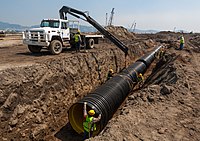
Photo from wikipedia
This paper presents a modular hydromechanical approach to assess the short- and long-term surface drainage behavior of arbitrarily deformable asphalt pavements. The modular approach consists of three steps. In the… Click to show full abstract
This paper presents a modular hydromechanical approach to assess the short- and long-term surface drainage behavior of arbitrarily deformable asphalt pavements. The modular approach consists of three steps. In the first step, the experimental characterization of the thermomechanical asphalt material behavior is performed. In the second step, information about the long-term material behavior of the asphalt mixtures is integrated on the structural scale via a finite element (FE) tire-pavement model for steady-state rolling conditions and time homogenization in order to achieve a computationally efficient long-term prediction of inelastic deformations of the pavement surface (rut formation). In the third step, information regarding the current pavement geometry (deformed pavement surface) is used to carry out a surface drainage analysis to predict, e.g., the thickness of the water film or the water depth in the pavement ruts as a function of several influencing quantities. For chosen numerical examples, the influence of road geometry (cross and longitudinal slope), road surface (mean texture depth and state of rut deformation), and rainfall properties (rain intensity and duration) on the pavement surface drainage capacity is assessed. These parameters are strongly interrelated, and general statements are not easy to find. Certain trends, however, have been identified and are discussed.
Journal Title: Advances in Materials Science and Engineering
Year Published: 2020
Link to full text (if available)
Share on Social Media: Sign Up to like & get
recommendations!